集合框架-HashMap
1.7版本分析
数据结构实现
数组(基本)+链表(扩展)
属性
//默认hash表容量大小 2^4=16 static final int DEFAULT_INITIAL_CAPACITY = 1 << 4; //最大hash表容量大小,必须是2的整数幂 static final int MAXIMUM_CAPACITY = 1 << 30; //默认加载因子 static final float DEFAULT_LOAD_FACTOR = 0.75f; //表未膨胀时共享的空表实例。 static final Entry<?,?>[] EMPTY_TABLE = {}; //hash表resize,大小必须是2的整数幂 transient Entry<K,V>[] table = (Entry<K,V>[]) EMPTY_TABLE; //表中存在的key-value对实例数量 transient int size; //resize的阈值 (capacity * load factor) int threshold; //hash表的加载因子 final float loadFactor; //修改的次数,更多在于迭代时使用, fail-fast机制 transient int modCount; //map容量的默认阈值,高于该阈值的替代散列是用于字符串键。 //替代哈希降低了发生率由于字符串键的弱哈希码计算而导致的冲突。 static final int ALTERNATIVE_HASHING_THRESHOLD_DEFAULT = Integer.MAX_VALUE; //hash种子初始值 transient int hashSeed = 0;
构造方法
1 //基本基于这个方法,如:HashMap(),默认16,0.75f 2 public HashMap(int initialCapacity, float loadFactor) { 3 if (initialCapacity < 0) 4 throw new IllegalArgumentException("Illegal initial capacity: " + 5 initialCapacity); 6 //最大也只有2^30 7 if (initialCapacity > MAXIMUM_CAPACITY) 8 initialCapacity = MAXIMUM_CAPACITY; 9 if (loadFactor <= 0 || Float.isNaN(loadFactor)) 10 throw new IllegalArgumentException("Illegal load factor: " + 11 loadFactor); 12 this.loadFactor = loadFactor; 13 //resize的阈值 就是给定的初始容量 14 threshold = initialCapacity; 15 //钩子方法 16 init(); 17 }
重要方法
put
public V put(K key, V value) { //判断是否没存放元素 if (table == EMPTY_TABLE) { //初始化数组表,阈值,hash种子 inflateTable(threshold); } if (key == null) //可存储key为null的,如果没存则会专门创建一个entry在bucket中且index为0. //有了则替换value return putForNullKey(value); //通过位运算(计算机底层运算,远比%速度快) 得到hash散列值 int hash = hash(key); //通过hash值 与 表长度-1(底层方法) 进行与运算,控制下标一定会在长度范围内 //如key='a'时,hash=103,length-1=15;0110 0111&0000 1111 = 0000 0111=7 int i = indexFor(hash, table.length); //拿到当前数组下标位上的链表,没有则跳过,否则以它是否有下一节点来进行遍历 for (Entry<K,V> e = table[i]; e != null; e = e.next) { Object k; //先判断key是否一致,是则用新值替换旧值 if (e.hash == hash && ((k = e.key) == key || key.equals(k))) { V oldValue = e.value; e.value = value; e.recordAccess(this); return oldValue; } } modCount++; //在此hash新增一个entry,底层createEntry方法,如果当前index处已经有了entry //那Entry<K,V> e = table[bucketIndex]; 会先拿到当前index的entry,即上一次添加的 //table[bucketIndex] = new Entry<>(hash, key, value, e);再将上一次的entry设置为 //新增的entry的next,且将新增的entry设置为当前index的首个元素(头插法) //(即每次新增的都会成为链表的第一个元素,位于数组下标处) addEntry(hash, key, value, i); return null; } private void inflateTable(int toSize) { // Find a power of 2 >= toSize 根据当前的阈值得到2的整数幂 int capacity = roundUpToPowerOf2(toSize); //设置新的阈值 capacity * loadFactor threshold = (int) Math.min(capacity * loadFactor, MAXIMUM_CAPACITY + 1); //设置新的容量大小 table = new Entry[capacity]; //初始化hash种子 initHashSeedAsNeeded(capacity); } final int hash(Object k) { //初始值为0,put、扩容会计算有值 int h = hashSeed; if (0 != h && k instanceof String) { return sun.misc.Hashing.stringHash32((String) k); } h ^= k.hashCode(); h ^= (h >>> 20) ^ (h >>> 12); return h ^ (h >>> 7) ^ (h >>> 4); } //获取当前容量下的hash 索引 static int indexFor(int h, int length) { return h & (length-1); }
put流程图

get
public V get(Object key) { //特殊的:key为null if (key == null) return getForNullKey(); // Entry<K,V> entry = getEntry(key); return null == entry ? null : entry.getValue(); } final Entry<K,V> getEntry(Object key) { if (size == 0) { return null; } //同样的先根据key得到hash值 int hash = (key == null) ? 0 : hash(key); //再计算出index,去数组中对应的下标拿 entry数组遍历 for (Entry<K,V> e = table[indexFor(hash, table.length)]; e != null; e = e.next) { Object k; //拿到相同hash值的 entry,没有则返回null if (e.hash == hash && ((k = e.key) == key || (key != null && key.equals(k)))) return e; } return null; }
入队数组&扩容实现
上述put源码时,分析了当hash碰撞时,链表的插入为头部插入法,即每次新增的key都是链表头节点。
扩容源码
void resize(int newCapacity) { //保存旧数组 Entry[] oldTable = table; //保存旧容量 int oldCapacity = oldTable.length; //作下容量判断处理,如果旧容量已经是最大了,则设置阈值为最大且直接返回 if (oldCapacity == MAXIMUM_CAPACITY) { threshold = Integer.MAX_VALUE; return; } //用新容量创建的新数组 Entry[] newTable = new Entry[newCapacity]; //initHashSeedAsNeeded 用新容量得到新的hash种子 transfer(newTable, initHashSeedAsNeeded(newCapacity)); //将新数组替换旧的数组 table = newTable; //阈值设置为2*旧容量*0.75 与 最大取小 threshold = (int)Math.min(newCapacity * loadFactor, MAXIMUM_CAPACITY + 1); } //真正的从旧到新的转换 void transfer(Entry[] newTable, boolean rehash) { //2*旧容量 int newCapacity = newTable.length; for (Entry<K,V> e : table) { //遍历hash表中每个位置(下标)上的链表 while(null != e) { //记录旧的next Entry<K,V> next = e.next; if (rehash) { //重新计算hash值 e.hash = null == e.key ? 0 : hash(e.key); } //根据上面计算的hash值 & 新容量 计算新hash桶中的下标位置 int i = indexFor(e.hash, newCapacity); //头插法,所以需要将之前可能有的entry放到e的next去 e.next = newTable[i]; //将当前e放到hash表中i位置头部 newTable[i] = e; //继续遍历 e = next; } } }
单线程put&扩容图
假设:有一个长度为2的hash表,已有的数据如图1.1
扩容:继续put数据(k4,v4),按hashmap的扩容(即旧容量*2)
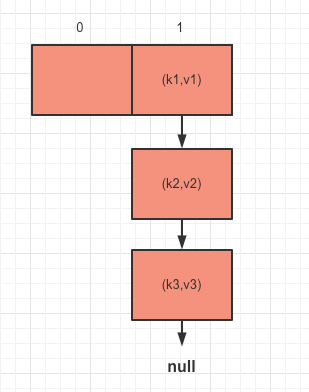
图1.1
扩容&转移数据到新table中
第一步转移k1:

第二步转移k2:

第三步转移k3:
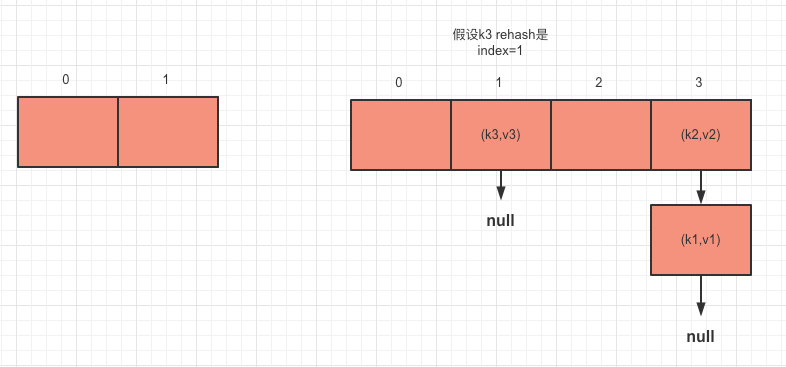
第四步put:
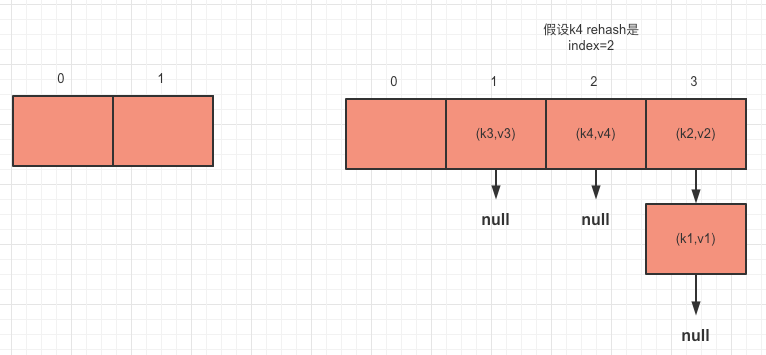
多线程put&扩容图
场景:在图1.1的基础上,有两个线程T1和T2同时进行put,然后需要扩容的操作。
结合代码(主要就是while循环里)
while(null != e) { Entry<K,V> next = e.next;//No.1 if (rehash) { e.hash = null == e.key ? 0 : hash(e.key); } int i = indexFor(e.hash, newCapacity); e.next = newTable[i]; newTable[i] = e; e = next; }
1.当T1在No.1行挂起了的时候,此时的T1和T2如下图2.1和图2.2
由于T1中是旧的hash表,e=k1,next=k2,而T2已经转换过去新hash表了。
图2.1

图2.2
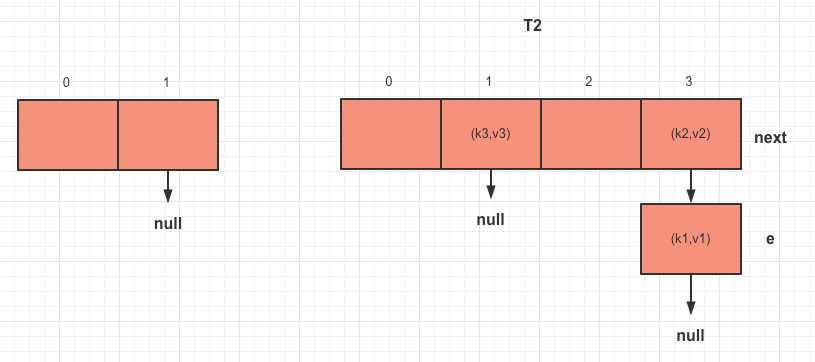
2.T1在此时被唤醒(e=k1,next=k2)
2.1它已经新建了一个hash数组,当计算了hash并执行到e.next = newTable[i]时,k1的next指向的是T1线程中的新hash表(全部为空,如图2.1),index=3处的头部元素为null,即e.next=null
2.2当执行到newTable[i] = e; 将index=3处设置为k1。
2.3当执行到e = next; 即e=k2。此时状态如图2.3
图2.3

2.4继续循环,e=k2,e.next=k1, 执行e.next = newTable[i],即e.next=k1
2.5当执行到newTable[i] = e; 将index=3处头元素设置为k2。
2.6当执行到e = next; 即e=k1。此时状态如图2.4
图2.4

2.7继续循环,e=k1,e.next=null,
执行e.next = newTable[i],即e.next=k2(即k1又会指向k2,此时🉑k2的next指向的是k1)
2.8当执行到newTable[i] = e; 将index=3处头元素设置为k1。
2.9当执行到e = next; e=null 。此时状态如图2.5
图2.5
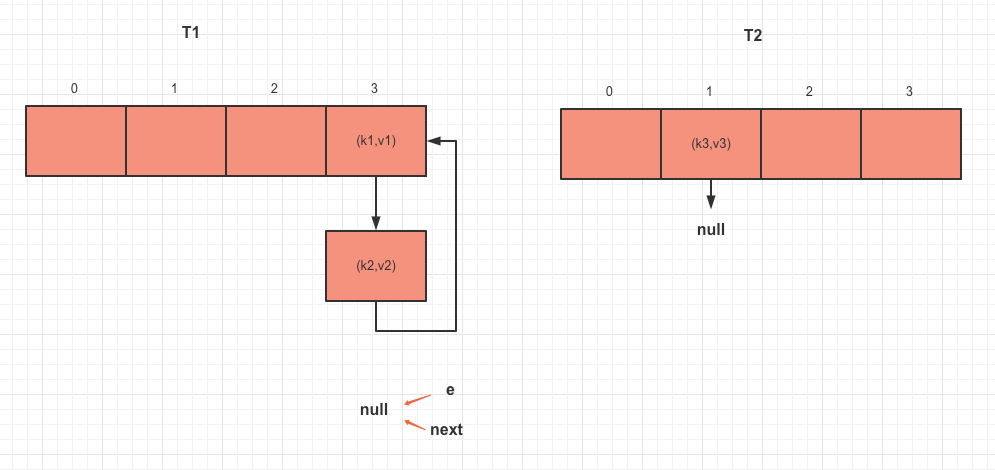
看最终图结果得知,k1和k2之间形成了相互的next节点指向,导致死环了。这也是1.7版本严重的问题所在。
1.8版本分析
引入了bucket,位桶的概念,来表示每个hash表index位置处的节点数。
数据结构实现
数组(基本)+链表(扩展)+红黑树(扩展)
链表转红黑树问题
为什么规定长度>=8时,转红黑树?8是怎么来的?
理想情况下使用随机的哈希码,容器中节点分布在hash桶中的频率遵循泊松分布。按照泊松分布的计算公式计算出了桶中元素个数和概率的对照表,可以看到链表中元素个数为8时的概率已经非常小,再多的就更少了。
属性
//默认hash表容量大小 2^4=16 static final int DEFAULT_INITIAL_CAPACITY = 1 << 4; //最大hash表容量大小,必须是2的整数幂 static final int MAXIMUM_CAPACITY = 1 << 30; //默认加载因子 static final float DEFAULT_LOAD_FACTOR = 0.75f; //链表转红黑树阈值 static final int TREEIFY_THRESHOLD = 8; //红黑树转回链表阈值 static final int UNTREEIFY_THRESHOLD = 6; //链表转红黑树时,hash表容量需到达的最小容量阈值,否则优先扩容 static final int MIN_TREEIFY_CAPACITY = 64; //表未膨胀时共享的空表实例。1.8用内部类Node实现 transient Node<K,V>[] table; //内部类EntrySet实现,用来存放不重复keys transient Set<Map.Entry<K,V>> entrySet; //表中存在的key-value对实例数量 transient int size; //resize的阈值 (capacity * load factor) int threshold; //hash表的加载因子 final float loadFactor; //修改的次数,更多在于迭代时使用, fail-fast机制 transient int modCount;
构造方法
//只给了默认的加载因子 public HashMap() { this.loadFactor = DEFAULT_LOAD_FACTOR; } //基本基于这个方法,如:HashMap(),默认16,0.75f public HashMap(int initialCapacity, float loadFactor) { if (initialCapacity < 0) throw new IllegalArgumentException("Illegal initial capacity: " + initialCapacity); //最大也只有2^30 if (initialCapacity > MAXIMUM_CAPACITY) initialCapacity = MAXIMUM_CAPACITY; if (loadFactor <= 0 || Float.isNaN(loadFactor)) throw new IllegalArgumentException("Illegal load factor: " + loadFactor); this.loadFactor = loadFactor; //初始化容量且设定阈值 this.threshold = tableSizeFor(initialCapacity); } //通过多次按位右移,来获得一个2的整数次幂 static final int tableSizeFor(int cap) { int n = cap - 1; n |= n >>> 1; n |= n >>> 2; n |= n >>> 4; n |= n >>> 8; n |= n >>> 16; return (n < 0) ? 1 : (n >= MAXIMUM_CAPACITY) ? MAXIMUM_CAPACITY : n + 1; }
重要方法
put
public V put(K key, V value) { //先计算得到hash值 return putVal(hash(key), key, value, false, true); } //采用低16位与高16位进行异或处理获取hash值,更加平均分布 //参考:https://blog.csdn.net/qq_42034205/article/details/90384772 static final int hash(Object key) { int h; return (key == null) ? 0 : (h = key.hashCode()) ^ (h >>> 16); } final V putVal(int hash, K key, V value, boolean onlyIfAbsent, boolean evict) { Node<K,V>[] tab; Node<K,V> p; int n, i; //判断table是否没初始化过,是则进行阈值、容量等的初始化 if ((tab = table) == null || (n = tab.length) == 0) n = (tab = resize()).length; //求indexof,与1.7类似 if ((p = tab[i = (n - 1) & hash]) == null) //hash表index处没元素,直接new一个node存放 tab[i] = newNode(hash, key, value, null); else { //否则,追加链表(红黑树)处理 Node<K,V> e; K k; //判断插入的key是否与头部key相等,是就替换值,后方判断 if (p.hash == hash && ((k = p.key) == key || (key != null && key.equals(k)))) e = p; //不相同,判断是否是红黑树 else if (p instanceof TreeNode) e = ((TreeNode<K,V>)p).putTreeVal(this, tab, hash, key, value); //链表处理 else { //binCount 用来计数链表的长度,判断转红黑树的阈值,是当前下标处的链表转 for (int binCount = 0; ; ++binCount) { if ((e = p.next) == null) { p.next = newNode(hash, key, value, null); //判断转的阈值,不过底层还会判断整个hash表的容量是否大于64才会进行转 if (binCount >= TREEIFY_THRESHOLD - 1) // -1 for 1st treeifyBin(tab, hash); break; } //用来判断链表中的key是否与当前插入的key相等,是就替换值,后方判断 if (e.hash == hash && ((k = e.key) == key || (key != null && key.equals(k)))) break; p = e; } } //key相等时,新值替换旧值 if (e != null) { // existing mapping for key V oldValue = e.value; if (!onlyIfAbsent || oldValue == null) e.value = value; afterNodeAccess(e); return oldValue; } } ++modCount; //再判断下当前hash表的容量是否超过了扩容阈值 if (++size > threshold) resize(); afterNodeInsertion(evict); return null; }
get
public V get(Object key) { Node<K,V> e; return (e = getNode(hash(key), key)) == null ? null : e.value; } final Node<K,V> getNode(int hash, Object key) { Node<K,V>[] tab; Node<K,V> first, e; int n; K k; //table不为空、table长度大于0、且第一个元素不为null 否则直接返回null if ((tab = table) != null && (n = tab.length) > 0 && (first = tab[(n - 1) & hash]) != null) { //判断hash值和key if (first.hash == hash && // always check first node ((k = first.key) == key || (key != null && key.equals(k)))) return first; //判断下一节点是否为空 if ((e = first.next) != null) { //如果已经是红黑树了,用它自己的获取节点的方法 if (first instanceof TreeNode) return ((TreeNode<K,V>)first).getTreeNode(hash, key); //否则走链表遍历判断是否有key do { if (e.hash == hash && ((k = e.key) == key || (key != null && key.equals(k)))) return e; } while ((e = e.next) != null); } } return null; }
入队数组&扩容实现
1.7的是头插法,而1.8采用的是尾插法。具体看代码和图形分析。
扩容&转移源码
//1.8+中都放在一个方法了 //作用:1初始化阈值、容量;2扩容;3扩容后的转移 final Node<K,V>[] resize() { //记录旧的hash表 Node<K,V>[] oldTab = table; //记录旧的表容量 int oldCap = (oldTab == null) ? 0 : oldTab.length; //记录旧的扩容阈值 int oldThr = threshold; int newCap, newThr = 0; //初始化过了 if (oldCap > 0) { //判断容量是否到达最大了 if (oldCap >= MAXIMUM_CAPACITY) { //是的话,直接设置阈值也为最大 threshold = Integer.MAX_VALUE; return oldTab; }//否则判断 newCap=2*oldCap是否大于最大容量,oldCap是否大于默认的容量16,都是则扩容 else if ((newCap = oldCap << 1) < MAXIMUM_CAPACITY && oldCap >= DEFAULT_INITIAL_CAPACITY) //newThr=2*oldThr(如12*2=24) newThr = oldThr << 1; // double threshold } //如前面调用了hashmap的带参构造方法,第一次放map时,oldCap会=null,而oldThr会大于0 //把容量设置为阈值 else if (oldThr > 0) newCap = oldThr; else {//使用默认的初始化 newCap = DEFAULT_INITIAL_CAPACITY; newThr = (int)(DEFAULT_LOAD_FACTOR * DEFAULT_INITIAL_CAPACITY); } if (newThr == 0) { float ft = (float)newCap * loadFactor; newThr = (newCap < MAXIMUM_CAPACITY && ft < (float)MAXIMUM_CAPACITY ? (int)ft : Integer.MAX_VALUE); } threshold = newThr; @SuppressWarnings({"rawtypes","unchecked"}) //用新容量创建新的hash空表,并给到table Node<K,V>[] newTab = (Node<K,V>[])new Node[newCap]; table = newTab; if (oldTab != null) { //遍历旧hash表上 每个bucket for (int j = 0; j < oldCap; ++j) { Node<K,V> e; if ((e = oldTab[j]) != null) { oldTab[j] = null; //判断下一节点 if (e.next == null) newTab[e.hash & (newCap - 1)] = e; //判断红黑树 else if (e instanceof TreeNode) ((TreeNode<K,V>)e).split(this, newTab, j, oldCap); //链表 else { //这里扩容,将同一个桶中的元素分为了两个链表来处理,低16位和高16位判断 //即在新的hash表中,根据当前index划分了两个index位置, //见最后两个判断高低位是否有链表的方法, //低位是直接在index处, //而高位是index+oldCap,避免重新计算hash位置,缩短时间 Node<K,V> loHead = null, loTail = null; Node<K,V> hiHead = null, hiTail = null; Node<K,V> next; do { next = e.next; //低16位 if ((e.hash & oldCap) == 0) { if (loTail == null) //直接放到链表首部 loHead = e; else loTail.next = e; loTail = e; } //高16位 else { if (hiTail == null) hiHead = e; else hiTail.next = e; hiTail = e; } } while ((e = next) != null); if (loTail != null) { loTail.next = null; newTab[j] = loHead; } if (hiTail != null) { hiTail.next = null; newTab[j + oldCap] = hiHead; } } } } } return newTab; }
扩容示意图
假设:hash表中,i=3处已有一个红黑树的数据,以及后面某index处有一个链表不超过8的数据(表容量没超过64)。
如图:

按resize方法的扩容来,无法达到转红黑树的条件,即走的是链表的处理:
Node<K,V> loHead = null, loTail = null; Node<K,V> hiHead = null, hiTail = null; Node<K,V> next; do { next = e.next; if ((e.hash & oldCap) == 0) { if (loTail == null) loHead = e; else loTail.next = e; loTail = e; } else { if (hiTail == null) hiHead = e; else hiTail.next = e; hiTail = e; } } while ((e = next) != null); if (loTail != null) { loTail.next = null; newTab[j] = loHead; } if (hiTail != null) { hiTail.next = null; newTab[j + oldCap] = hiHead; }
争对J处的数据,假定k4,k5在一个hash,k6,k7在一个hash上。
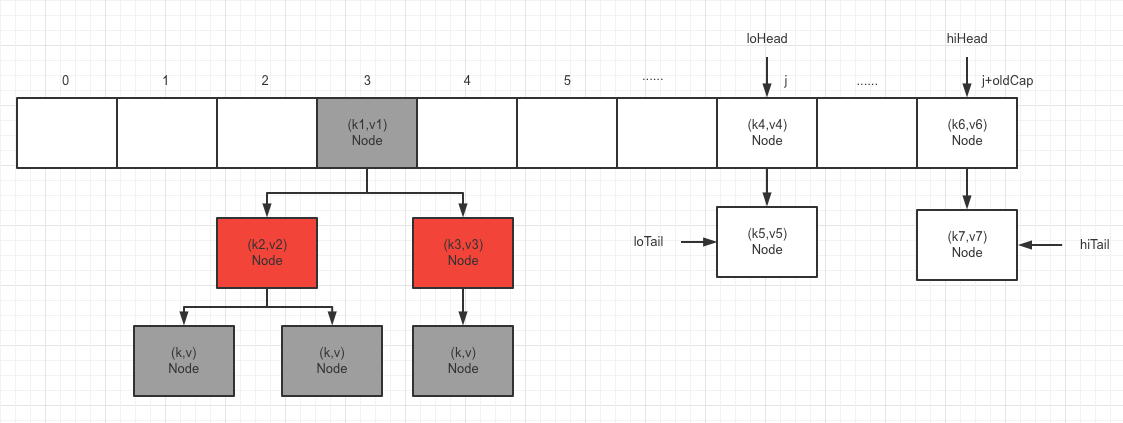
很明显,当采用了高低位拆分转移方式时,避免了链表死环的产生。
参考
参考链接:

